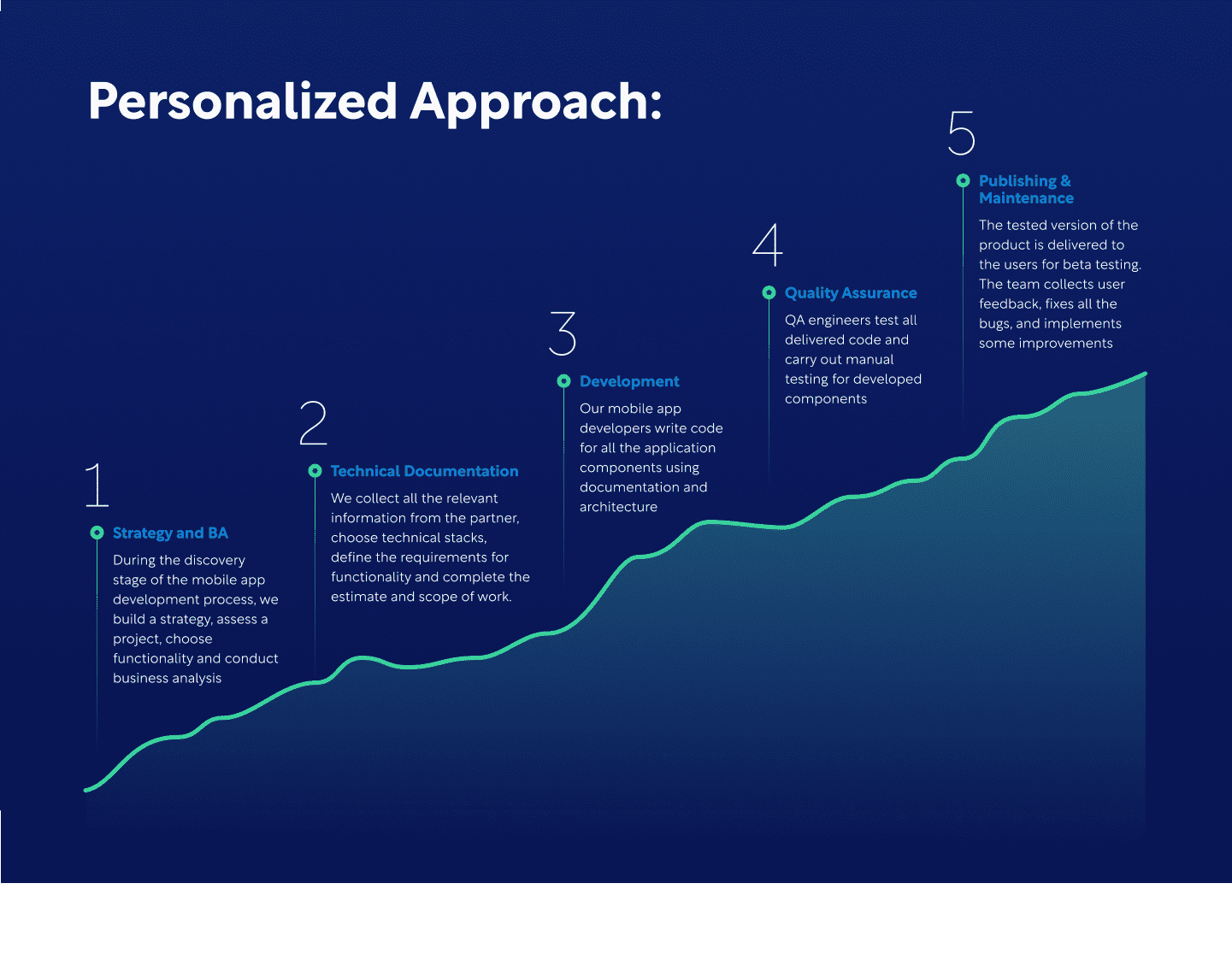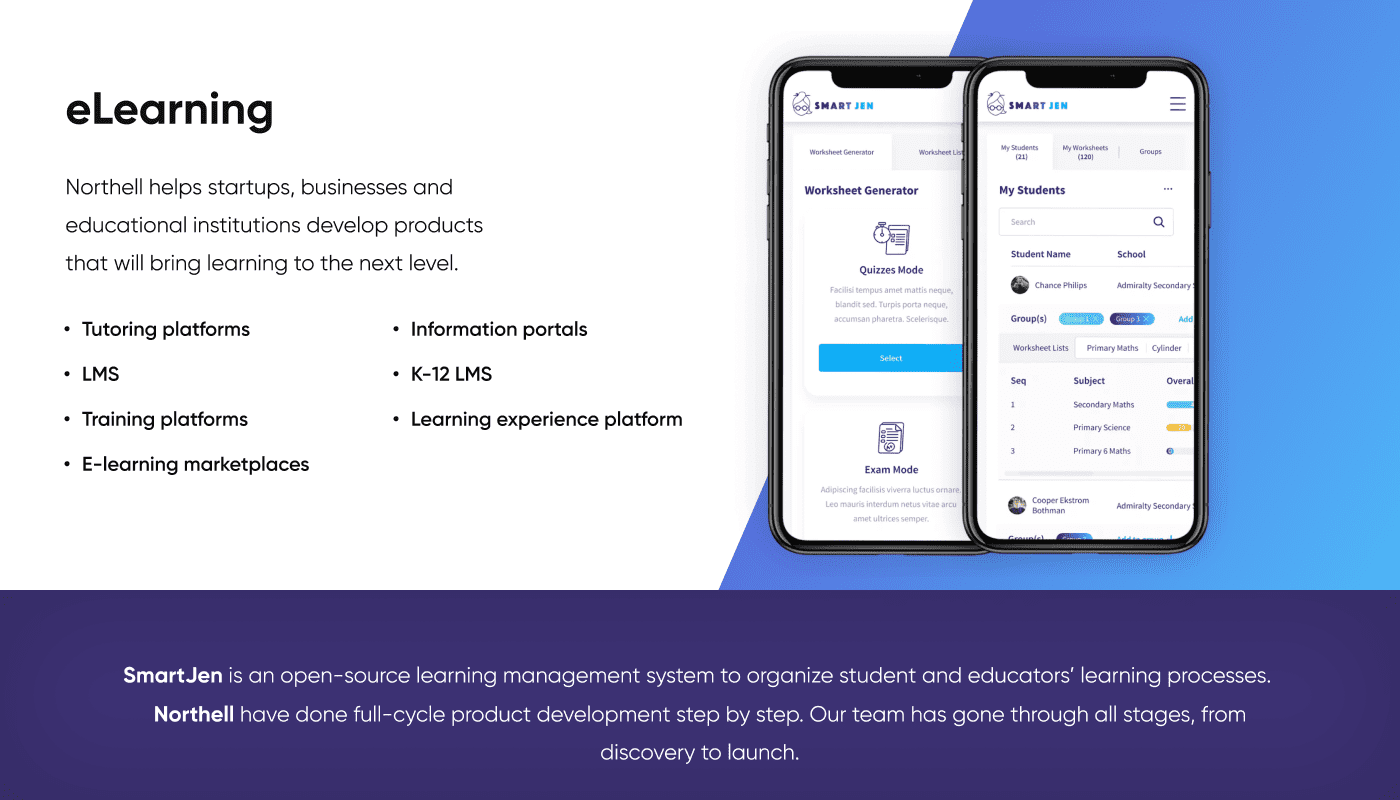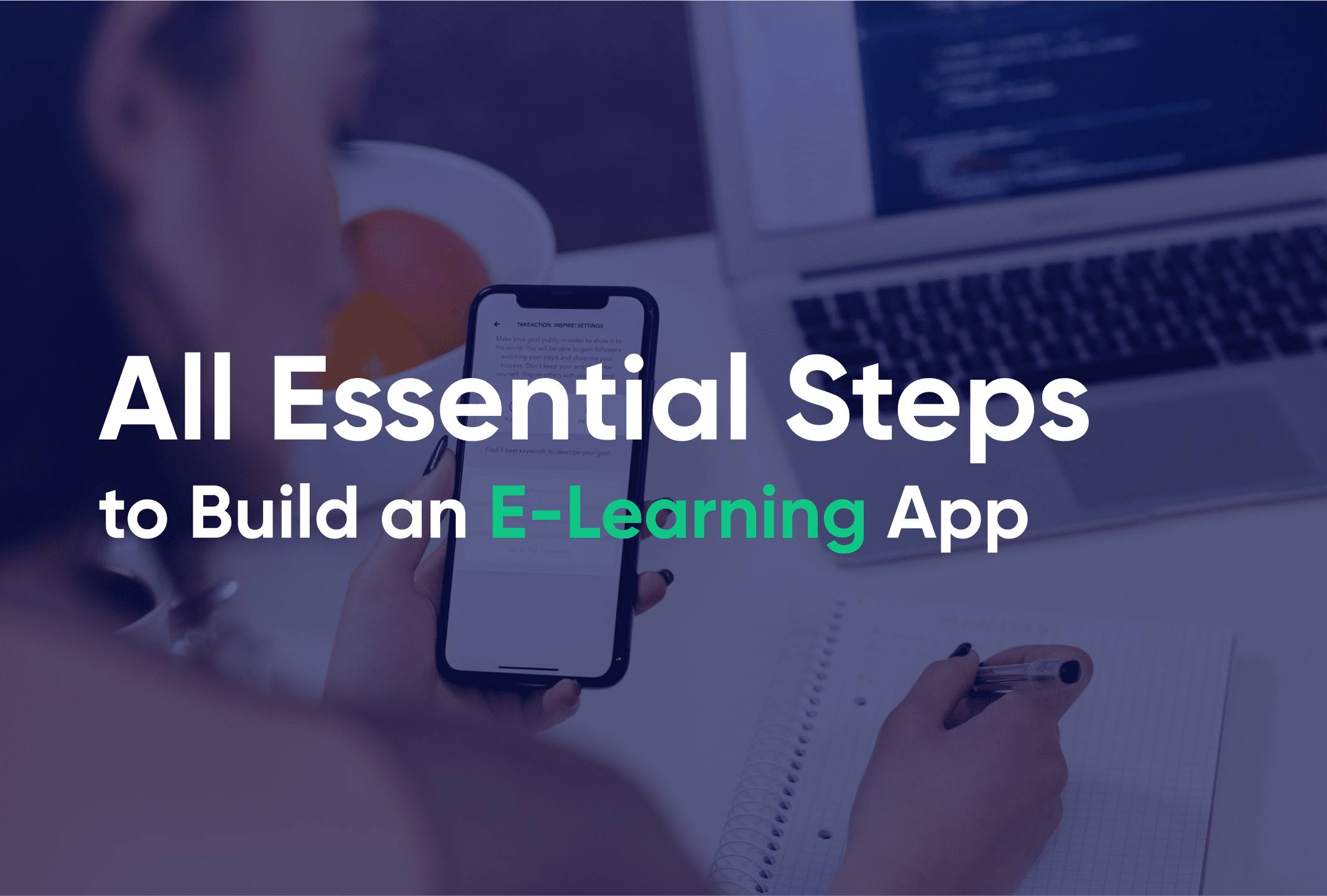Content
An e-learning app is an interactive application that allows students to input data and get expected results on their devices. The learners need just their smartphones with an internet connection to access such an app.
The University of Potomac has surveyed their students and found that almost 70% of all students claim online learning is as good as or better than offline.
So, no wonder that by 2025, the market of online learning is expected to reach a 200% increase. So, due to the ever-growing demand, it is a viable choice to start working on satisfying this demand now. How to do it? Create the e-learning apps. But first, let’s take a closer look at the market itself.
E-Learning App Market Overview
The most important aspect you should know about e-learning apps is that they are not only used by educational institutions.
For instance, it was reported that 98% of US-based corporations used some form of online learning in 2020. Yes, according to a survey in which 2,500 global companies, “comprehensive training programs” resulted in a 218% profit increase.
So, the demand for e-learning mobile app development is constantly growing and is expected to do so in the years to come. Let’s now take a look at how you can benefit from the grown demand.


Who Needs Custom E-Learning App Development?
Though business opportunities are limitless, we will focus on two cases here. We will view why existing learning-related businesses need to go digital and why it is a good idea to establish a startup in the field. Let’s dive in!
Why Should Existing Companies and Startups Create an E-learning App?
Finding the right specialist is a very challenging task. Sometimes the heads of companies have no choice but to improve the qualifications of their employees and help them master new skills. Thus, many large corporations in the USA and Europe are investing in the corporate education of their staff.
What’s more, representatives of the higher education system also have to teach and prepare people who will work in the digital economy.
E-learning apps come to the rescue in this case, and they are already being actively implemented by companies in various fields of activity.
So e-learning mobile app development is worth the struggle for both existing companies and startups. There are many niches you can operate in. For instance, you can offer solutions for corporate-level training, language courses, and many other educational solutions.
However, you should keep in mind some aspects. Let’s take a look at them together.
How to Check Your E-Learning App Idea?
What Do You Want to Change in the Company or Industry?
Firstly, you need a preliminary analysis that will show whether your application has the potential. You should:
- Carry out a physical survey according to principle ten pains and ten gains;
- Read negative reviews on your competitors. Doing so will help to identify your “don’ts and avoid some mistakes;
- Hold a decomposition of your business plan. How do you plan to monetize? How much time will the free trial take?;
All these activities will help you see what you want to change in the industry, and this, in turn, will help you figure out how you will do it.
Engage Consultants
Try to seek expert advice from more experienced colleagues or a team who has experience in this business field.
Go all the Way With your Future User
Doing so will help you understand the pains of your potential user and identify what your user wants.
Find out Why People Choose Your Competitors? (Survey, Reviews, etc.)
You should know your competitors like the back of your hand. What do they do right? And what do they do wrong? Read reviews on their products, find their weaknesses, and come up with solutions to them.
How to Create a Great E-Learning App Idea?
Choose a Clear Niche
You don’t want to create another similar application. You want to create something unique. So, research the market and define a niche you will operate in.
Choose a Clear Target Audience
You should clearly analyze the market and your target audience. Who are they? Are they individual teachers and learners that need a mediator? Are they large corporations that want to adopt company-wide learning applications?
A Strong Team Always Comes First
To create an e-learning app that has the potential to succeed, you need skilled professionals. Yes, effective project delivery takes teamwork. E-learning mobile app development requires:
- software developers to work on code itself
- designers to ensure your e-learning app looks great
- testers to take responsibility for the code quality
- project manager to manage the tasks within e-learning mobile app development
- business analyst to understand the market state and needs
Apart from that, your e-learning app should have top-notch content in place. So, you have to streamline a strict selection criterion for the teachers or mentors you work with.
Use Trends, but Don’t Always Create Them
You should be aware of the current trends that prevail in the market. However, keep in mind that “trendy” does not mean “perfect-fitting”. So, use trends wisely.
Close the Need for an Existing Process
As we have mentioned above, you have to know your potential customers’ pains and needs. You have to know for sure what pain or need you are addressing with your product.
Distinguish Between Client Pain and Desire
Dwelling a bit more on the previous point, your clients’ desires and pains are different things. You have to address the pain but don’t forget about how your clients want their pains addressed.


mobile learning apps
![]()
![]()
Main E-Learning App Essential Features
Personal Account for Students and Teachers
You have to provide the ability to sign up for your e-learning app. The user should be able to fill in the personal information, add credit cards, etc.
It is also a good idea to make different interfaces for learners and teachers, as the feature set they need will also be different. For instance, teachers should be able to keep track of their students, payments, progress with each of them, etc. At the same time, learners should have a clear schedule of both classes themselves and payments for them.
Course System
The course system is probably the most comprehensive feature when you create an e-learning app. Such a system manages the whole learning process. Typically it looks as follows: virtual learning materials are delivered through interactive courses to virtual classrooms.
The latter, in turn, are integrated into a mobile learning environment. The main goal of the course system is to streamline the process for teachers for more convenient learning material creation.
With all that said, keep in mind that the convenience of this system is decisive for teachers that choose the application to work with.
Online Testing System
The application should help its users run tests, preferably with measures that prevent cheating. For instance, you can make it impossible to quit the application when a test is still in progress, set time frames when a learner has to finish a test, etc.
Chat, Online Class, and Video Calls
Quality chats and video calls are primarily important when it comes to e-learning applications, as they replace face-to-face communication. So, you have to ensure a sound technical basis for the video calls, making them accessible, understandable, and easy to use.
Certification System
Another critical feature for you to consider during e-learning app development is the ability to issue certificates confirming that a particular learner has mastered a particular course. This system should be secured so that it is impossible to get a certificate without taking a test first.
Rating and Evaluation System
You have to carefully work on the evaluation system when you create an e-learning app. The teachers should be able to set clear acceptance, passing, and evaluation criteria. Also, it is a good idea to set deadlines in this section of your e-learning application.
Reminder and Notification System
The learning process is closely connected to deadlines. And they are frequently difficult to track. So, if you wonder how to create an e-learning app that will be popular with users, it should be helpful in the first place. Take care of the pains your users have, take these pains into account during e-learning app development.
For instance, you can send notifications on the upcoming deadlines, due payments, tests your users have to take, etc.
Homework System
Your application should help the learners hand their assignments in easily. At the same time, the teachers should be able to grade them as well as assign new ones, set deadlines, etc. So, take your time to develop a comprehensive homework system.
Connecting Payment Gateways
Secure payments must be among your priorities. So, make sure to integrate secure payment gateways (e.g., PayPal, Apple Pay, Google Pay, etc. ) to your e-learning application to make payments both convenient and safe.
A Step-by-Step Guide on How to Create an E-Learning App


1. Describe and Develop Your Idea for a Ready-Made Business Project
You need to describe your idea clearly and communicate it to your vendor. It is a good idea to come to a vendor with clear requirements, references, do’s and don’ts.
2. Make a Business Plan and Technical Requirements for the Product
You must describe your problems and visions clearly so that your e-learning mobile app development team has a clear idea of what needs to be done. Without precise requirements, your team will not know how to create an e-learning app that will help you succeed.
Typically, the document with requirements comprises such aspects as project overview, your needs and goals, the audience you want to target, your desired features set, recommendations, references, prohibitions, etc.
3. Find Reliable Partners to Build a Mobile Application
Your business success heavily depends on whom you choose to partner with. So, take your time to find a reliable provider to create an e-learning app successfully.
Your partner should be able to create and scale your team promptly. And speaking of a team for e-learning mobile app development, it has to be strong and experienced. You definitely need professionals such as business analysts, designers, developers, DevOps experts, QAs, etc.
Also, it is a good idea to assess the tech portfolio as well as testimonials of the vendor’s previous customers. You can find such information on directories (e.g., Clutch, the Manifest, FoodFirms, and others).
4. Beginning of Iteration Planning and Construction of MVP
MVP stands for a minimum viable product. It is a primary working product of the complete intended project, with only the core features. When the MVP becomes a complete product, it will be a working application as it will have been practically tested.
MVP is one of the most popular product development strategies. MVP development companies enable one to come up with a working product that has been practically validated through user interaction.
5. Start Product Discovery
At this stage, RewiSoft professionals carefully research the market, conduct a competitor analysis, as well as the analysis of your target audience. Also, during this stage, it is critical to identify business, users, and discovery goals, create user stories and customer journey maps. All these activities help to get through information on the product itself, the market it will operate on, its target audience, etc.
6. Define MVP Functions
MVP enables testing your idea before it is fully developed. It facilitates easy modification of the product. Features are added and removed, depending on how the clients are responding to the MVP product. So, think about what features you should try first.
7. Start UX Design
Before this phase, make sure the goals of your UX design are clear. The key activities RewiSoft can help you with at this stage are:
- sketching your ideas
- developing prototypes
- gathering user input
- make design decisions
Based on the concept of the application and its design, we prepare a roadmap to start the UX design process. During this stage, we create the information architecture and wireframes.
8. Do a User Testing
The testing stage allows bringing the prototype to a perfect state. There are three vital stages of testing: interview the focus groups, assessment research, and usability reports.
Learn more about the stages of product design here.
One of the bright examples of user experience testing is the RewiSoft UX Lab. The user in our lab gets a prototype.
Eye-tracking equipment captures how a user acts when interacting with the product. After that, the system displays the information, which allows comparing the data of actual use and analytics. Based on this, the product will be adjusted to boost its usability.
9. Start UI Design
Consistency is the most critical aspect of the UI design stage. RewiSoft experts will ensure that all interface elements on your website will be of the same style, use your brand colors, and pick the fonts that will suit you the most.
10. Build a Development Process [SDLC]
10.1 Product Technical Documentation
During this stage, all the relevant information from the client is collected to develop a product as per expectations and requirements. The team should write technical documentation and choose technical stacks.
At this stage, the team should also define the requirements for functionality (requirements for the admin panel) and user roles (admin and super admin). The team should finalize the estimate and scope of work.
Typically you need professionals in such technology stacks – Swift for iOS apps, Kotlin for Android apps, and React Native for cross-platform applications.
10.2 Development
Front-end developers are responsible for the client-side of the application. Back-end developers are accountable for API and database development. DevOps team working on the CI/CD process. QA engineers test all delivered code and write automated tests for developed components.
However, when it comes to mobile app development, typically there is no strict division between front-end and back-end. So, basically you just need a skilled mobile app developer.
10.3 Testing
QA engineers test all delivered code and perform manual testing for developed components.
10.4 Deployment & Integration
After the development and regression testing from the QA team, the tested version of the software is delivered to the users for beta testing.
10.5 Maintenance
After the deployment of a product in the production environment comes the maintenance stage. If any issue comes up and needs to be fixed, if something is to be improved – the development team is responsible for all these activities at this stage.
11. Launch
Now is the time for the market to see your product! The product launch process should be carried out systematically to guarantee that clients accept the product favorably. The following are the significant steps to a successful product launch process:
- Identifying target audience
- Creating unique product packaging;
- Creating slogan and timeline;
- Competitor analysis;
- Application development;
- Customer onboarding;
- Advertising.
RewiSoft Expertise in e-Learning App Development?


e-Learning App Development
RewiSoft professionals build successful tech products. Our team consists of middle and senior-level specialists. We provide full-cycle custom software development.
RewiSoft helps startups, businesses and educational institutions develop products that will bring learning to the next level. In the education field, we have created tutoring platforms, LMSs, training platforms, e-learning marketplaces, information portals, and learning experience platforms.
We worked with SmartJen, a sophisticated open-source learning management system, to organize student and educators’ learning processes. The company helps find the perfect target audience, create multiple campaign sequences and optimize campaigns to drive even more results.
SmartJen empowers students to quickly go through their learning journeys, check results, and track their achievements via a customizable dashboard. Teachers can create and manage students’ lists, groups, and worksheets with assignments, track course completion and compliance. With a collaborative approach, parents are granted access to have control over their children’s learning processes.
SmartJen came to RewiSoft to enhance their existing mobile app and a web platform by suggesting more advanced features to make the user experience smoother. What’s more, SmartJen’s existing website needed to be updated according to recent best development practices.
Due to versatile users and market research, we were equipped with a clear vision of SmartJen’s unique value proposition. Evaluating the problems of the existing platform, we are now able to make customers’ journeys smoother, as well as enhance user flows.
How much does E-Learning App Development cost?
At RewiSoft, the starting price for developing a E-Learning App is $30,000.
Like any other field, the prices for mobile app development vary among regions, as they heavily depend on the cost of living there. Apart from that, the price depends on the seniority level of the task performers, workload, the difficulty of a task, and a range of other factors.
There are three most popular outsourcing destinations: Eastern Europe, Asia, and Latin America. Each of these locations has its peculiarities, and prices there are different. Let’s see how much does it cost to create an e-learning app with vendors from these destinations.
Eastern Europe
The cost to create an e-learning app in Eastern Europe depends on the country of the region you choose. Yes, rates of mobile application developers in Ukraine are lower than those in Romania or Poland. The lower cost of living in the country is – the lower the rates are. So, we recommend taking the cost of living index by Numbeo to the account.
When it comes to the seniority level of the professionals, the rate of a junior mobile app developer is around $35 per hour, while hiring a senior will cost you about $50 per hour.
Asia
If you’re searching for a mobile app developer in Asia, rates here amount to $10-$15 for a junior mobile app developer and $20-30 for a senior mobile app developer.
Although the rates in Asia are the lowest in the global labor market, the region lags behind others in terms of digital adoption and the quality of the Internet. These factors may hamper your cooperation with developers based in Asia.
Latin America
One of the key factors that drive businesses (mainly US-based) to outsource mobile app development to Latin America is geographical proximity and little time difference.
If you choose to hire a junior mobile app developer in Mexico, Argentina, or other Latin American countries, prepare to spend from $30 per hour for junior professionals to $50 per hour for senior mobile app developers.
Prices for mobile app development by project size
Typically, we distinguish startup-, middle-, and enterprise-level projects according to their complexity.
The cost to develop an application also depends on your project’s size. Small or startup-level projects require less time to develop, fewer professionals involved, and, thus, are less expensive. On average, startup-level projects take around 150 hours to develop.
Average rates for mobile e learning apps development per technology in different regions:
| Tech stack | Eastern Europe | Western Europe | South America | Asia |
| Java | $30-60/hr | $65-80/hr | $35-70/hr | $20-45/hr |
| React Native | $30-55/hr | $60-65/hr | $30-40/hr | $25-40/hr |
| Swift | $40-60/hr | $60-70/hr | <$40/hr | <$35/hr |
| TypeScript | $40-50/hr | $55-65/hr | <40/hr | <40/hr |
| Kotlin | $40-50/hr | $50-60/hr | <40/hr | <35/hr |
How to Create an E-Learning App: Summary
No matter if you are a startup, have an educational web platform, or an existing offline business – e-learning app development will be beneficial for your business. However, there are different aspects to consider. For instance, you have to test your idea, come up with the features set you would like to implement, and gather a strong team.
The team should unite the experts including developers, DevOps experts, QAs, business analysts. Also, when the application is ready, you have to streamline the process to work with the best teachers, mentors or other people who will be responsible for the content of your e-learning application.
As far as the development process itself is concerned, you have to go through different stages. They are, for instance, writing project requirements, creating a business plan, undergoing product discovery, developing MVP, working on UI/UX design, mobile app development, and more.
So, e-learning app development is a comprehensive process. This path, however, gets more manageable if you partner with a reliable provider like RewiSoft.
It requires many stages and comes together with some challenges.







